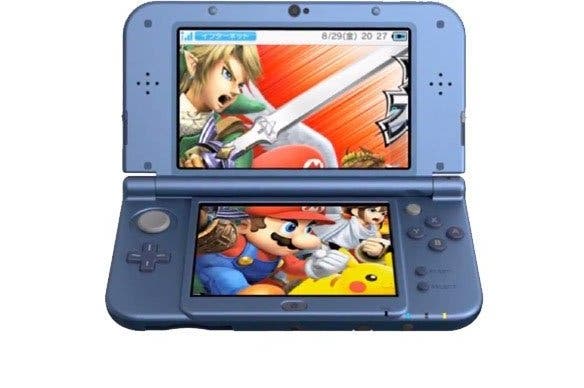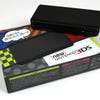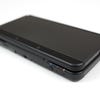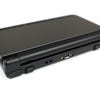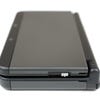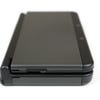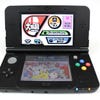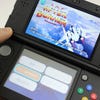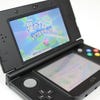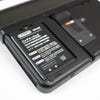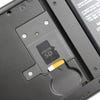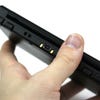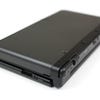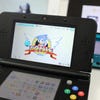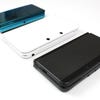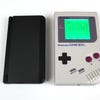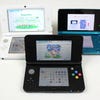New Nintendo 3DS review
New and improved - and now available in the UK.
Nintendo's New 3DS handheld is out in the UK today. Digital Foundry originally reviewed the hardware back in October 2014, but the comments and criticisms remain equally as valid today, so we're republishing the article for those considering an investment in the revised hardware.
Nintendo's attempts to give its portable hardware renewed momentum haven't always been entirely successful; the Game Boy Pocket - twinned with Pokémon - may have rejuvenated the fortunes of its 1989 forefather, but 2005's Game Boy Micro - the final iteration of the Game Boy Advance - was markedly less successful. Nonetheless, this constant desire to tinker and enhance its handheld platforms has been a major part of the Kyoto giant's strategy for almost three decades and shows no signs of being abandoned any time soon; in fact, Nintendo's current pocket-sized console - the 3DS - has seen three revisions in as many years, and it has just received its fourth facelift.
The New Nintendo 3DS is - perhaps - the machine that 2012's 3DS XL should have been all along. It seeks to fix the many issues that have dogged the system since its inception, including shaky 3D viewing angles, the lack of a second analogue stick and sluggish performance when moving around the user interface. The good news is that it is successful in each respect and even adds some additional bonuses, making it without a doubt the definitive version of the 3DS hardware. This new system comes in two flavours; the standard New 3DS and the New 3DS XL (known as the LL in Japan). Both share a similar design, but the smaller model - presumably aimed at younger players, if the colourful and cartoon-like packaging is anything to go by - boasts interchangeable 'Kisekae' faceplates and eye-catching buttons that replicate the colour scheme seen on the iconic Super Famicom/SNES controller. Aside from the obvious differences in overall dimensions, screen size and battery capacity, the internal tech is identical across both units.
Before we delve into the technical whys and wherefores of the New 3DS, it's perhaps wise to dwell a little longer on what physical improvements it offers over its forerunner. The most obvious is the introduction of a second analogue controller, dubbed the C-Stick by Nintendo in an attempt to align it with the famous yellow nub on the GameCube joypad. This nipple-like protrusion is fashioned from a rubber and feels very stiff upon first use; it's essentially the same concept as the IBM ThinkPad's pointing stick. Only a moderate amount of pressure is required to register a directional input, and its placement next to the face button cluster means that it's comfortable to switch between the two control elements.
- Order the New Nintendo 3DS from Amazon with free shipping
By factoring in a second stick, the New 3DS effectively absorbs the capabilities of the much-maligned Circle Pad Pro accessory - the system even showcases the two additional shoulder buttons introduced by that bulky and impractical add-on, ZL and ZR. Situated to the side of the existing L and R keys, these are easy enough to reach with your fingertip but accessing all four buttons simultaneously requires some deft digit placement, with your middle knuckle feathering the L and R keys while the tips of your fingers rest further inward, on the newer keys.
New controls are just one way in which Nintendo has changed the feel of its latest handheld - other existing elements are shifted around in ways that both delight and befuddle. The volume control is now located on left-hand edge of the top screen directly opposite the 3D slider, meaning you're less likely to unintentionally knock it during play. The WiFI toggle has been expunged completely, and now wireless connectivity is controlled entirely via the user interface - another welcome change that means no lost StreetPass hits from accidentally knocking the switch when the console is in transit. The start and select keys have been pushed to the right-hand side of the touchscreen, while the bottom edge of the console - previously the sole preserve of the 3.5mm headphone socket - is now festooned with inputs and other elements. The stylus dock, game card slot and power button have all been repositioned here, but the last two changes don't feel quite right. While download-heavy players might be able to ignore the placement of the cart slot, the power button is awkward to find with your finger and would have been much better off in its original location next to the touch panel, protected by the upper screen when the unit is closed. While the button thankfully won't turn off the console when it's in your bag or pocket, it will power it up if you've already switched it off.
The other notable aspect of the standard New 3DS model is the presence of the Kisekae face plates - pieces of thin plastic which clamp onto the front and back of the device. The bottom of the stylus - which is disappointingly stubby and feels somewhat cheap when compared to the metal telescopic version shipped with the very first 3DS - is used to prise off the front plate, but a crosshead screwdriver is required to fully remove the rear panel - the reason being that the battery and MicroSD card slot are contained underneath, and should the panel accidentally unclip, you're likely to lose one or the other. The Kisekae plates are exclusive to the smaller New 3DS model, and Nintendo clearly sees them as a very valuable revenue stream - more than 40 different alternatives are on offer in Japan already. While we can understand reasoning behind the New 3DS LL missing out on such customisation - that version is aimed at adults - but we can't help but feel that Nintendo is going to miss out on some vital cash as a result. Grown-ups like colourful cases too, after all.
Moving away from the physical properties of the New 3DS, the internal benefits of this revised system are just as striking. The most obvious is the vastly improved auto-stereoscopic 3D effect, which now uses the front-facing camera to detect where your head is and adjusts the image accordingly. On previous 3DS models, even tilting the console very slightly would be enough to break the 3D image and ruin the effect, causing blurring and double images to appear on the screen. However, the New 3DS all but eradicates this irksome issue; it's possible to turn the unit quite aggressively and still have a rock-solid picture, because that camera is constantly monitoring your relative position and compensating for movement by adjusting the parallax barrier screen. Deconstructing the process isn't hard; simply turning your head away from the console and then quickly looking back at it causes the 3D image to "jump" as it recalibrates and locks onto your face once more - subtle movements are picked up as well, which suggests that the console's accelerometer is also being called into play. Even so, it's an astonishingly effective solution to what was a very bothersome problem for 3DS owners.
Under the bonnet Nintendo has tinkered with the internal tech to provide some welcome improvements. The CPU is now faster, which means that navigating around the 3DS menu is much quicker - for example, the painful pause which traditionally accompanies pressing the home button during a game is now all but removed, and loading and boot-up times are markedly decreased as well. Downloads are also much faster, and browsing the web is less akin to pulling teeth this time around. The browser also features a filter to block adult content - a wise move, given Nintendo's family-friendly outlook - though this can be disabled by paying a small fee via a credit card. Elsewhere, NFC tech has also been factored into the New 3DS - a necessity with amiibo around the corner. We were unable to test this feature during the review, but it will involve placing the amiibo figure directly onto the touchscreen to exchange data and trigger events in games.
The titles we tested on the New 3DS didn't play any differently when compared to the standard console, despite the bolstered CPU. This is to be expected given that they were coded with the original system in mind, but Nintendo has promised that some future releases will make use of the refreshed hardware - one of the first being a portable conversion of the cult Wii RPG Xenoblade Chronicles, expected next year. While many will welcome the chance to see more technically accomplished games on their Nintendo handheld, this strategy is not without its risks; there are more than 45 million 3DS, 3DS XL and 2DS owners out there already, and none of them will be able to play any of the New 3DS software on their beloved systems. Fragmenting the market in such a fashion could inspire fans to upgrade to the newer model, but it will also cause the kind of confusion that has relentlessly dogged the Wii U during its rather torrid commercial lifespan. For the average consumer, discerning which 3DS software is compatible with which 3DS system could prove to be a serious headache.
The standard New 3DS comes with a 1400 mAh battery, which is slightly weedy when you consider that many modern smartphones have power cells with more than twice that capacity. As a result, stamina isn't drastically different from what has gone before; Nintendo quotes around an hour more of play time on this version (three-and-a-half to six hours) when compared to the original 3DS from 2011 (three to five hours). During our review period we found that a pretty fair claim, but we still had to charge the system more often than we'd have liked. The story is largely the same for the New 3DS XL, which offers only a slight improvement over the old XL console when it comes to longevity between charges. Given that battery life has been one of the biggest bones of contention since the 3DS hit the market a few years back, it's slightly disappointing to see that Nintendo hasn't taken this opportunity - surely its last, given the age of the hardware - to calm the criticism with a more capacious battery.
New Nintendo 3DS: the Digital Foundry verdict
The New 3DS is very much about iterating on what has gone before rather than promising a full-scale revolution - but at the same time, as far as Nintendo hardware refreshes go, it's one of the most drastic; easily on par with the paradigm shift that was the Game Boy Advance SP, which famously introduced a backlit colour screen and a rechargeable battery to Nintendo fans for the first time ever. The processor bump makes the core UI faster and allows for better games in the fullness of time, with the unfortunate caveat being that existing 3DS owners aren't invited to the party. The head-tracking improves the system's much-hyped glasses-free 3D effect remarkably, while the addition of a second analogue stick offers the kind of control that really should have been present in the console when it first launched.
While Japan, Australia and New Zealand will enjoy this new system in 2014, the rest of the world is going to have to sit it out until next year. The delay in Europe and North America could have something to do with not having software to show off the system's finer points - such as the second stick. Crucially, the Japanese release has been tied in with the launch of Monster Hunter 4G (known in the west as Monster Hunter 4 Ultimate) which utilises the C-Stick for controlling the camera, and it's rather telling that the presence of a special New 3DS LL bundle including Capcom's game resulted in that model outselling the standard New 3DS by almost three to one. Clearly software is vital in selling the benefits of this updated console, and that is perhaps why Nintendo has resisted the urge to conduct a wider worldwide release in 2014. Irrespective of the reasons, this is a upgrade worth waiting for - and is likely the final throw of the dice for the 3DS range.
